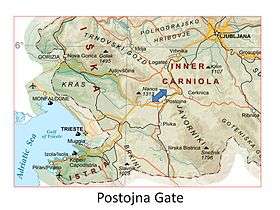Postojna Gate
| Postojna Gate | |
|---|---|
 | |
| Elevation | 606 m (1,988 ft) |
| Traversed by | Slovenian A1 freeway, Austrian Southern Railway |
| Location | Inner Carniola, Slovenia |
| Range | Dinaric Alps |
| Coordinates | 45°47′N 14°13′E / 45.783°N 14.217°ECoordinates: 45°47′N 14°13′E / 45.783°N 14.217°E |
 Postojna Gate Location of Postojna Gate | |
The Postojna Gate (Slovene: Postojnska vrata), also Adriatic Gate and Italo-Illyrian Gate,[1] is a major mountain pass of the Dinaric Alps. Located in Slovenia, the pass's approximately 30-kilometre (19 mi) wide saddle allows for the lowest crossing of the Dinaric Alps, at an elevation of 606 metres (1,988 ft)[2] and a second higher crossing at the Hrušica plateau. It is bordered to the south by the Javornik Hills (Javorniki) and to the north by the Trnovo Forest Plateau (Slovene: Trnovski gozd). The gate connects the Pannonian Plain, the eastern Alps, the western Balkans, and Czech territories with northern Italy and the northeastern Adriatic coast.[1] It is a watershed between the Adriatic and the Danubian drainage basins and takes its name from the local town of Postojna.
The gate was used by a section of the Amber Road that connected the Baltic lands with the Adriatic.[1] It has been proposed that the voyage of the Argonauts is based on the possibility to travel the Danube, the Sava, and the Ljubljanica rivers upstream, cross the Postojna Gate, and come to the Adriatic Sea downstream on the western side.[1] The Romans were well aware that their core territory was threatened by easy access through the Postojna Gate and they created a network of strategic roads, castles, and walls, the Claustra Alpium Iuliarum, to stop possible invaders.[1][3] At the center of these fortifications was the hill fortress of Ad Pirum on the Hrušica Plateau controlling the Roman road between Ljubljana and northern Italy. The Postojna Gate was crossed by the Alemanni, the Goths, and the Huns when they invaded Italy.[1] By about AD 600 Slavs populated the area and crossed the gate to enter the Istrian peninsula.[1] In the Middle Ages a number of castles were built, including Predjama Castle, Prem Castle, and Sovič Castle.[3]
In modern times, the gap was crossed by the Austrian Southern Railway (Südbahn), the railway that was built between 1839 and 1857 to connect Vienna via Ljubljana to Trieste. The Slovenian A1 freeway passes through the gate.
References
- 1 2 3 4 5 6 7 Peter Stih. "Slovene History". Retrieved 2010-02-14.
- ↑ author unknown. "Postojna Cave". Retrieved 2010-02-14.
- 1 2 Andreja Penko. "Regio Carsica Militaris". Retrieved 2010-02-15.